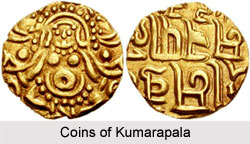 Jaya Singh Siddaraja had no son, and he died in 1143 A.D. In 1144 his near relation Kumarapala forcibly occupied the throne. Kumarapala was a very brave and courageous person and Jaya Singh himself was an admirer of his qualities. But Jaya Singh did not want to make him his successor because he was the grandson of a dancer and so he adopted a minister`s son named Bahad and declared him as his successor. After Jaya Singh`s death an attempt was made to make Bahad the king. But Kumarapala opposed this and became the king after driving away Bahad. Kumarapala also killed all those persons who opposed him.
Jaya Singh Siddaraja had no son, and he died in 1143 A.D. In 1144 his near relation Kumarapala forcibly occupied the throne. Kumarapala was a very brave and courageous person and Jaya Singh himself was an admirer of his qualities. But Jaya Singh did not want to make him his successor because he was the grandson of a dancer and so he adopted a minister`s son named Bahad and declared him as his successor. After Jaya Singh`s death an attempt was made to make Bahad the king. But Kumarapala opposed this and became the king after driving away Bahad. Kumarapala also killed all those persons who opposed him.
Following are the important events of his reign that can be mentioned below.
War with Chahamana king Arnoraj: After being driven away by Kumarapala, Bahad sought the shelter of Chahamana king. Chahamana king Arnoraja attacked Kumarapala but was defeated and Bahad was made prisoner. Thereafter Arnoraj married his daughter with Kumarpala and established friendly relations with him.
War with the Chalukyas of Malwa: With the help of Yasodhaval, Kumarapala attacked king Ballal of Malwa and killed him. Thus he brought under his authority the territory of Malwa up to Bhilsa.
War with Parmaras of Abu: While Kumarapala was busy, fighting against Arnoraj Parmara, just at that time king Vikram Singh of Abu revolted against him. Kumarapala attacked and made him prisoner. There after he made Yashodhaval as the king of Abu.
Revolt of Saurashtra: Prabandha Chintampni and other contemporary books indicate that the Somavarman was the ruler of Saurashtra. He had made a revolt against him but Kumarapala had suppressed this revolt. His minister Udayana was killed in the revolt. Kumarapala appointed the son of Somavarman as the ruler of Saurashtta.
War with Konkad state: Kumarapal killed king Mallikarajan of Konkad in the battle and established his rule there.
Second war with the Chahamanas: In the first war Chahamana king Arnoraja was defeated and he had married his daughter with Kumarapala. Scholars are of the view that later on their relations were strained as a result of which Kumarapala again attacked and defeated Arnoraja.
On the basis of said conquests it can be said that Kumarapala was a great conqueror. The Chalukya dynasty had made a great progress during his reign as well. He led military campaigns to the Sindhu in the West, Ganges in the east, Turushaka land in the north and Vindhya Mountain in the south. This seems to be an exaggerated statement. However, the truth is that his empire extended to Bhilsa in the east, Kathiawar in the west, Chitod in north and Narmada in the south.
Culture progress-a great cultural progress was made during the reign of Kumarapala. His reign is famous for education and construction work. It is said that he had adopted Jain religion being influenced by Hemchandra and thereafter prohibited slaughter of animals. It is said that in this beginning he was Shaiva but later on became a follower of Jain religion. He repaired many temples. Hemchandra Surya was the famous scholar of his reign whose famous work is `Kumarapala charit`.
Kumarapala died near about 1171 A.D.



















